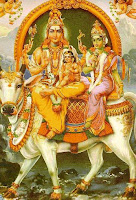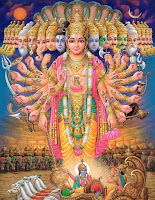Om.
Hope everyone had a good start to the new year.
A new year is a source of great expectation and hope. It is a time when everyone wishes for a transformation of their plight. The habit of making new year resolutions is a good step forward for this purpose. But, we seldom follow such resolutions and they end up as frustrations.
Here is a simple ritual that can be made an easy habit this year so that you are able to really transform your life with the blessings of god.
Everyday in the morning, after your bath, face the east direction and chant 'OM Gum Ganapathaye Namah'.
Then chant 'OM Namo Vasudevaya Namah'.
Now turn clockwise and face the south direction.Chant 'OM Sri Adi Parashakthaye Namah'.
Then face the west direction and chant 'OM Namah Shivaya'
Now turn anti-clockwise and face the north direction and chant 'OM Sarvadevathaya Parabrahmane Namaha'
Then turn clockwise and face the east direction again. Chant 'OM' 5 times.

This simple and easy daily routine can help you to be protected and blessed by all the celestial beings.
Hope everyone had a good start to the new year.
A new year is a source of great expectation and hope. It is a time when everyone wishes for a transformation of their plight. The habit of making new year resolutions is a good step forward for this purpose. But, we seldom follow such resolutions and they end up as frustrations.
Here is a simple ritual that can be made an easy habit this year so that you are able to really transform your life with the blessings of god.
Everyday in the morning, after your bath, face the east direction and chant 'OM Gum Ganapathaye Namah'.
Now turn clockwise and face the south direction.Chant 'OM Sri Adi Parashakthaye Namah'.
Then face the west direction and chant 'OM Namah Shivaya'
Now turn anti-clockwise and face the north direction and chant 'OM Sarvadevathaya Parabrahmane Namaha'
Then turn clockwise and face the east direction again. Chant 'OM' 5 times.

This simple and easy daily routine can help you to be protected and blessed by all the celestial beings.
Hope everyone has a happy, healthy and prosperous 2012.
May God Bless Everyone and Everything.
Om

